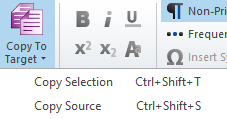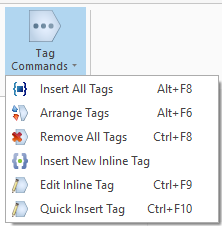Ribbons - Edit
The Edit ribbon appears when you work on a document in the translation editor, or when you are working on a list of segments marked by quality assurance or by Find and replace. It also appears when you are transcribing images.

Cut: Cuts (deletes) the selected text from the target cell, and copies it to the clipboard. Shortcut key: Ctrl+X or Shift+Del.
Copy: Copies the selected text to the clipboard. Works from the source cell as well as from the target cell. Shortcut key: Ctrl+C or Ctrl+Insert.
Paste: Inserts the text from the clipboard at the cursor position; or replaces the selection with the contents of the clipboard. Copies formatting and tags, too. Shortcut key: Ctrl+V or Shift+Insert.
Copy to target: Copies text from the source cell to the target cell (in the same row; without the clipboard). Opens a menu:

- Copy Selection: Copies the selected text from the source cell to the target cell in the same row. First, place the cursor in the target cell where you want to copy the text. Then select the text to copy in the source cell. Shortcut key: Ctrl+Shift+T.
- Copy Source: Copies the entire source cell to the target cell in the same row. If you select two or more rows, copies the source text to the target cell in all the selected rows.Shortcut key: Ctrl+Shift+S.
The icons in this section are as follows, from left to right, and from top to bottom:
Bold: Formats the selected text in bold characters, or removes the bold formatting. Shortcut key: Ctrl+B.
Italic: Formats the selected the text in italics, or removes the italic formatting. Shortcut key: Ctrl+I.
Underline: Underlines the selected the text, or removes underline. Shortcut key: Ctrl+U.
Superscript: Puts the selected text in superscript, or restores it to normal text.
Subscript: Puts the selected text in subscript, or restores it to normal text.
Toggle Case: Switches the selected text from lowercase through Uppercase Initials to ALL UPPERCASE, and back to all lowercase - in the target segment. Shortcut key: Shift+F3.
Non-Printing Characters: Shows non-printing characters (spaces, non-breaking spaces etc.), or hides them.
Frequent Symbols: Inserts a special character that you choose from a menu. Inserts right-to-left (RTL) and left-to-right (LTR) markers, too, if the target language uses Arabic or Hebrew script.

Insert Symbol: Inserts any symbol or Unicode character. Opens the Insert symbol window. Shortcut key: Ctrl+Shift+I.
Tag Insertion: Turns automatic tag insertion on or off (normally, it is turned off). When it is turned on, you can click to insert the tags in the target cell. Shortcut key: F6.
Copy Next Tag Sequence: Copies the next sequence of inline tags or memoQ tags into the target cell. A tag sequence consists of tags immediately following each other, regardless of the type. Always inserts the first tag sequence that has not been inserted yet. Shortcut key: F9.
Inserts tag pairs, too: To insert a pair of tags at once, select the text that must be enclosed, and press F9. memoQ will insert two tag sequences, one before and one after the selected text.
Inline Tags: Changes the level of detail of tags that memoQ shows. Opens a menu:

-
 Show Short Inline Tags: memoQ shows inline tags in their most compact form. All you can see is a tag, its number, and if it is an opening
Show Short Inline Tags: memoQ shows inline tags in their most compact form. All you can see is a tag, its number, and if it is an opening  , a closing
, a closing  , or an empty
, or an empty  tag.
tag.Source segments: memoQ finds tag pairs based on tags' names and id attributes (when present - for example, rpr tags in DOCX files). Tags are numbered as they occur in the text, from left to right. Opening and closing tags have the same number. Empty tags have a unique number.
Target segments: memoQ uses the same way of pairing and numbering as in the source text. memoQ also matches tags with those in the source segment. If there is no matching tag in the source segment, the target-side tag gets a new number.
When you delete a tag, numbering does not change. memoQ only updates tag numbers when you reopen the document.
-
 Show Medium Inline Tags: memoQ displays the type (opening, closing, empty) and name, but no attributes.
Show Medium Inline Tags: memoQ displays the type (opening, closing, empty) and name, but no attributes. -
 Show Filtered Inline Tags: memoQ displays the type, name, and some attributes of inline tags. The attributes to show are part of the document type definition. If you are working on an XML file, they are a part of the filter configuration used to import the document. This is what memoQ normally shows.
Show Filtered Inline Tags: memoQ displays the type, name, and some attributes of inline tags. The attributes to show are part of the document type definition. If you are working on an XML file, they are a part of the filter configuration used to import the document. This is what memoQ normally shows. -
 Show Long Inline Tags: memoQ shows the type, name and every attribute of each inline tag. Caution: This setting might make the document unreadable, if tags are very long. Use it only if you are working to resolve a problem.
Show Long Inline Tags: memoQ shows the type, name and every attribute of each inline tag. Caution: This setting might make the document unreadable, if tags are very long. Use it only if you are working to resolve a problem.
Tag Commands: Opens a menu that contains more actions that you can perform on tags:

- Insert all tags
 : Copies every tag from the source cell to one position in the target cell. Use this only if there are a lot of tags, and their position does not matter, and you want to get rid of errors and warnings quickly. In other words, it is not recommended to use this command. You can also press Alt+F8.
: Copies every tag from the source cell to one position in the target cell. Use this only if there are a lot of tags, and their position does not matter, and you want to get rid of errors and warnings quickly. In other words, it is not recommended to use this command. You can also press Alt+F8. - Arrange tags
 : If the order of tags is wrong, this command will fix it. You can also press Alt+F6.
: If the order of tags is wrong, this command will fix it. You can also press Alt+F6. - Remove all tags
 : Removes all tags from the current target cell. Default shortcut key: Ctrl+F8.
: Removes all tags from the current target cell. Default shortcut key: Ctrl+F8. - Insert new inline tag
 : Inserts a new inline tag into the target cell. This means a tag that does not exist in the source cell. The tag must be allowed by the document type. The command opens the Inline tag window where you can choose the tag to insert.
: Inserts a new inline tag into the target cell. This means a tag that does not exist in the source cell. The tag must be allowed by the document type. The command opens the Inline tag window where you can choose the tag to insert. - Edit inline tag
 : Edits the selected tag. Opens the Inline tag window where you can change the tag. You can also press Ctrl+F9.
: Edits the selected tag. Opens the Inline tag window where you can change the tag. You can also press Ctrl+F9. - Quick insert tag
 : You can insert any tag that is allowed by the source document type. A list of tags appears on the right, where you can choose the tag to insert. Paired tags are inserted in pairs, not one by one. When inserting short inline tags, numbers are not visible on the list. You can also press Ctrl+F10.
: You can insert any tag that is allowed by the source document type. A list of tags appears on the right, where you can choose the tag to insert. Paired tags are inserted in pairs, not one by one. When inserting short inline tags, numbers are not visible on the list. You can also press Ctrl+F10.
Split Segment: Splits one source segment into two segments at the current cursor position. The target text will remain in the first segment. The newly created segment will be empty. First, place the cursor in the source cell to the position where you want to split the text. Shortcut key: Ctrl+T.
Join Segments: Joins two or more segments into one. If you do not select the segments, memoQ will join the current segment with the next. If there is text in the target cells, they are also joined. Shortcut key: Ctrl+J.
Add Abbreviation: For more accurate segmentation, adds an abbreviation to the segmentation rule set you use in the project. Offers to re-segment the document. Opens the Add abbreviation window.
Find: Finds text in the entire project, in the open documents, in the active alignment editor, or in the translation memory editor. Opens the Quick find or the Advanced find and replace window. Shortcut key: Ctrl+F. (For Advanced find and replace in a document, press Ctrl+F twice.)
Find next: Jumps to the next occurrence of the last expression you searched for. This happens in the same document as well as across documents. Does not open a window.
Replace: Finds and replaces text with another text in the entire project, in the open documents, in the active alignment editor, or in the translation memory editor. Opens the Quick find window with the replace options. Shortcut key: Ctrl+H. For the Advanced find and replace window, press Ctrl+H, and then press Ctrl+F.
Advanced: Opens the Advanced find and replace window.
Go To Next: Jumps to the next segment that fit the conditions you last set in the Goto Next Settings window. Shortcut key: Ctrl+G. If you need more options: Next to the icon, click the little arrow. A menu appears:

Go To Next: Jumps to the next segment that fit the conditions you last set in the Goto Next Settings window. Shortcut key: Ctrl+G.
Settings: Opens the Go to next segment window where you can choose what kind of segments you want to jump to. To learn more: See Help about the Goto Next Settings window. Shortcut key: Ctrl+Shift+G. This command jumps to a segment by the segment number, too.
Select All Text: Selects all text in the current segment. Selects text in either the source or the target segment, depending on the current cursor position. Shortcut key: Ctrl+A.
Select All Segments: Selects all segments in the document or view. Default shortcut key: Ctrl+Shift+A.
Do not press Ctrl+Shift+S after this, because that destroys the translations and cannot be undone.
Undo: Restores your document to the state before the last operation. You can undo multiple actions. Shortcut key: Ctrl+Z.
To undo several actions at once: Click the little arrow next to the icon. A menu appears:

The actions are listed in reverse order, newest first, oldest last. Click the oldest action that you want to undo.
Redo: Repeats the last operation you undid with the Undo command. You can redo multiple undo operations: The Redo icon has the same kind of menu as Undo. Shortcut key: Ctrl+Y.
Cannot undo changes after you close the document or synchronize it: memoQ forgets about actions when you close a document, or - when you work on the checkout of an online project - you synchronize the entire document with the server. The Help Center article about the Undo command explains why you cannot undo changes that were made before a full synchronization.